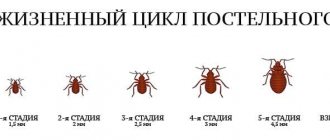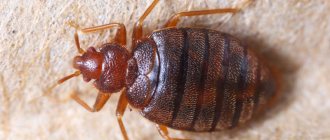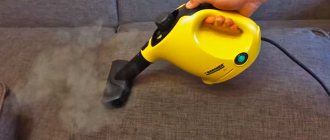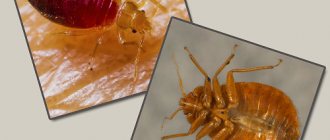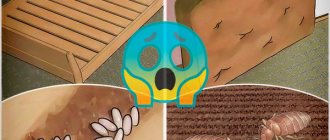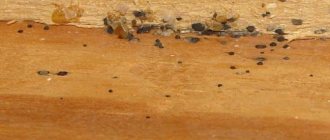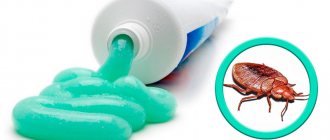- By Vil Malinoshevsky
- About bedbugs
Bed bugs, like any living creatures, require a comfortable air temperature for normal survival and reproduction. They can survive in a fairly narrow temperature range, and if the temperature gets too low or too high, they die.
A comfortable temperature regime for them is 25-30 °C. At the same time, they can live and remain active at a temperature of +10 ° C, but if it drops below -35 ° C, it kills them. First, the bedbugs fall into torpor, and the larvae stop hatching from their eggs. Long-term preservation of frost leads to their complete death. The same happens if the temperature rises above +45 °C. Moreover, the higher the temperature, the faster they die.
People use this feature of bedbugs when fighting them. For example, contaminated furniture is taken outside during severe frosts, things are washed in hot water, and apartments are treated with steam from a steam generator. Sometimes such measures are enough to kill bedbugs.
However, such insect control is not always effective. Sometimes it is not possible to detect all the nests of parasites and place them in the zone of extreme temperatures for them. Also, the reason for the survival of bedbugs may be a rapid change in temperature and its return to normal levels. For example, if the temperature lethal for bedbugs is maintained for a short time, they can withstand it and do not die.
We decided to conduct an experiment and check at what degrees and how quickly the bugs die. We also talked with exterminators who constantly destroy parasites using steam generators, and found out from them why residents themselves are not always able to kill insects using similar methods.
In literary sources, in particular Medical Entomology T.V. Vasilyevich says that adult bedbugs and larvae at +25-30 °C can survive up to 18 months without feeding. At plus 10 degrees, the parasites do not die; this only happens when the temperature drops to minus 17 °C. This temperature should remain for more than a day. Bedbugs die faster when the temperature rises. For example, at +45 °C they live no more than 45 minutes.
We checked the data in practice. If at +45 °C insects die in such a time, it means that with greater heating they should die faster.
Experiment: how quickly bedbugs die at +45 °C
For the experiment, we took three adult bedbugs and one nymph of the third or fourth instar. These are ordinary bed bugs that live at home at a standard temperature that is comfortable for them. Therefore, they should be afraid of its sudden changes.
At the beginning of the experiment, all bedbugs behave actively. We placed them in a small container, which we placed in a larger one. We increased the temperature in it to exactly +45 °C. The video shows that the reaction of insects placed in uncomfortable conditions is almost absent at first. They did not move more actively, trying to escape the heat that would kill them.
As our experiment showed, at a temperature of +45 °C, the bugs actually died in 45 minutes. This confirms that the facts in the book are true, which means that at -17 °C the insects will die in about a day.
Bugs that died during the experiment at a temperature of +45°C
In practice, it is very difficult to warm the air in an apartment to +45 °C and maintain such heat there for 45 minutes. It is easier to heat the room more, for example, to +55 ° C for 10-15 minutes. We decided to check how quickly the parasites would die at such a temperature, which is uncomfortable for humans, but completely safe.
Prevention
Clean the room regularly, shake out clothes in closets, arrange books on shelves, throw away everything unnecessary and superfluous: old carpets, tapestries, etc.
After purchasing and before installing new furniture, inspect it carefully. Insects may be found on new pieces of furniture.
Turn over and inspect the mattress in your bedroom from time to time. The favorite hiding place of parasites is closer to humans (this is what bed bug bites look like).
If you have a steam generator, periodically steam clean carpets, sofas, mattresses, etc.
When returning from your trip, wash all items at 50°C or higher or have them dry cleaned. Check your suitcases carefully. They can be treated with insect repellent, steam cleaner or iron.
Washing, cleaning and impregnating used items and furniture from bloodsuckers is a must.
Effect on bedbugs at temperatures of +50 °C
To conduct the experiment, we took the same four bed bugs and, by analogy, placed them in a small container, and that one in a larger one. The temperature was increased to 50 degrees.
As it turned out, an increase in temperature of just 5 degrees significantly accelerated the death of parasites. It only took 9 minutes. It is likely that as the air warms up even more, they die even faster. Unfortunately, we did not have any more live bugs left to continue the experiment.
Obviously, when the room is heated to 50 ° C, all the bugs in it will die in less than a quarter of an hour. It is unknown whether heat has the same effect on eggs. If they survive the heat treatment, then after 3-4 days larvae will appear from them. Consequently, after a week the apartment can be warmed up again and thus destroy all the young growth.
Survival and mortality of adult insects
It is possible to trace the relationship between changes in environmental conditions and parasite mortality. If this is clarified, then it may be possible to avoid the use of toxic substances in treatment. It is only important to know at what temperature bedbugs die. However, this is only possible if the number of insects is small and each individual nest is found.
Graph of bedbug death rate depending on temperature
The higher the temperature, the faster the insects will die. You can eliminate more bugs at one time.
Graph of the rate of death of bedbug eggs depending on temperature
The dependence of vital functions on environmental conditions can be seen on the graph.
Is it possible to freeze bedbugs out?
It is worth noting that high temperatures are more dangerous for bed bugs than low temperatures. Parasites are relatively accustomed to cold weather. They withstand winters in natural conditions, and sometimes face severe cold in residential buildings.
In the wild, bedbugs live in small caves along with bats, on whose blood they feed. They can also parasitize in rodent burrows and bird nests. Bed bugs are rare there; this habitat is more typical for other species that look very similar to house parasites and have a similar biology to them, but feed mainly on the blood of animals and birds. Bed bugs are now predominantly synanthropic insects, meaning they live exclusively in people's homes.
Bed bugs began to parasitize humans a very long time ago. The ancestors of bed bugs, which began to colonize human homes, could regularly experience temperatures dropping below zero degrees. This evolutionarily determined the relative resistance to cold.
Currently, populations of wild bed bugs are known that live in the caves of Turkmenistan in the Kopetdag. There they feed on the blood of bats, like their counterparts of other species. These bugs do not go deep into caves, remaining in places where the air temperature is affected by the weather outside. In summer, the air warms up there to a maximum of +20-22°C, and in winter it drops to +12-15°C, and near the entrance to the cave even to negative levels. At the same time, bedbugs continue to lead their natural way of life and tolerate the cold completely calmly.
At this time, the probability that the air in the cave will warm up to +40-45 °C is practically absent. It always remains cool there, since the space does not warm up and sunlight does not penetrate into it.
Thus, bedbugs are more accustomed to cold weather than to hot weather.
However, this is all relevant only for bed bugs. There are other species in nature that easily tolerate conditions that are harmful to domestic insects. In particular, triatomine bugs, which are common in Africa and the Amazon forests, feel normal at +45 °C. If this temperature is not comfortable for them, then it certainly does not lead to death. There is also the ground bug Nysius groenlandicus, which is considered the northernmost species on Earth. Its natural temperature is from 0 to +10 °C. With it, he lives and reproduces normally, calmly enduring frosts at the end of the cold Arctic summer. The eggs of these parasites can even survive polar winters, when the thermometer does not rise above -40-30 °C for six months.
Nysius groenlandicus - the same Arctic bug
When the temperature drops, bedbugs can enter a state close to suspended animation. At this time, all life processes in their body slow down. However, this state is not seasonal diapause; in other words, they do not hibernate.
However, you can “fry” bedbugs and freeze them out. But technically the second problem is easier to solve.
How to kill bedbugs with high temperature
You can heat the room to this temperature using a heat gun. It costs about 70-80 dollars, which is comparable to the cost of professional pest control of an apartment. The advantage of the gun is that it can be reused if parasites appear in the home again.
The experience of people who got rid of bedbugs in this way shows that the room needs to be heated to 55-60 ° C and maintained at this temperature for at least half an hour, but better than an hour. It is safe for people, but harmful for parasites. Warming up the room for a long time ensures that hot air gets into all the nests of parasites, and they die in the sofa, in the cracks, and in all other places.
Before heat treatment of the apartment, you need to move furniture away from the walls, dismantle sofas and beds, open all cabinets and drawers so that hot air penetrates all nests of parasites as quickly as possible.
In general, it is safe to say that high temperature is an effective means of killing bedbugs.
Freezing bedbugs as the most affordable alternative
The second option is to freeze the bedbugs out at low temperatures. This method is less universal and effective, and also has significant limitations. The most common way to implement this is to expose sofas and beds outside during severe frosts. In most cases, this does not bring the desired result. Since during the day bedbugs hide not only in the bed, but also in other places in the apartment, cleaning only one piece of furniture from them does not solve the overall problem. Even if all the bedbugs die in the sofa, they will still quickly colonize it again, moving from other nests.
This method can only be used for prevention, for example, when buying an old sofa or mattress. They can be left outside in sub-zero temperatures for 3-4 days to be sure that no parasites will enter the house with them.
It should be taken into account that, according to a manual on medical entomology, bedbugs die at -17 °C within 24 hours. Thus, if the temperature outside corresponds to this indicator or has dropped even lower, the furniture should be kept there for 2-3 days to be sure that all the bedbugs have died. If the thermometer only drops to -5 or -10 °C, then this will not have a significant effect on the parasites. They will not be able to move, bite or reproduce, but will retain their viability.
It is generally impossible to freeze bedbugs indoors. To do this, you need to ensure that the temperature there decreases for several days. Since most houses have water supply and heating systems, severe frost can lead to freezing of the liquid in them and rupture of pipes.
Climate influence
Insects that parasitize humans live and reproduce in the home. The climatic zone where a person's habitation is located is of secondary importance.
The microclimate of the room is very important for bedbugs. In a well-heated house located in Siberia, insects will be as comfortable as in a dacha located on the shores of the southern sea.
Many years of experience have made it possible to accurately determine at what temperature bedbugs die.
- They tolerate very hot microclimates worst of all. If the temperature is more than + 50 °C, the bug survives for less than 5 minutes. At 45 °C it can last for half an hour.
- Insect eggs are covered with a thermal protective layer, thanks to which they remain viable at +50 °C for 24 hours.
- Bedbugs tolerate low temperatures more easily. At a frost of 10 °C, they temporarily reduce activity, freeze, and enter a state of suspended animation.
- When the temperature drops another 5-7 °C, bedbugs can remain viable for up to 4 days.
- If the frost reaches 20 ° C, the insects will die within a few hours.
- Eggs tolerate low temperatures better. At -20 °C they can survive for 2 days, after which they die.
Bedbug nesting sites
Knowing the temperature at which bedbugs die allows you to safely do without chemicals.
Other ways in which bed bugs are exposed to extreme temperatures
There are other methods to effectively control bedbugs. For example, you can use a steam generator. Some Disincity exterminators use Karcher steam generators to treat baseboards and bed frames before treating a room with insecticides. Already during processing, scalded parasites crawl out of the cracks, the rest die there, not having time to get out.
These steam jets can be used to treat cracks in walls, joints of parquet or wooden boards on the floor, baseboards, mattresses and other places where insects often hide.
According to reviews of people who bought a steam generator for personal use, it is extremely rare to independently remove all the bedbugs with its help at one time. This is due to the fact that it is not always possible to open all the nests of parasites, or they are located in places that are extremely difficult to reach. At the same time, carrying out several treatments of the room with a short interval of time allows you to completely destroy the parasites.
Bedbugs also die when washing clothes at high temperatures. For example, if parasites got on your clothes during a trip or overnight stay in a hotel, you can wash them in a washing machine at maximum temperature. As a rule, a mode is set with heating water to 55-60 °C. In this case, there is no need to boil things: the parasites die at a lower temperature.
It is also recommended to wash clothes and all bedding when disinfesting an apartment with insecticides. It is very difficult to treat all textile products with them, and besides, it is not necessary. Bed bugs do not live in things that people frequently use and move. They prefer secluded places. Only single individuals can be found in things, which can be easily gotten rid of with regular washing.
Items that cannot be put in the washing machine, such as shoes, bags and children's toys, can be subjected to high temperatures in another way. For example, they can be placed in a car left in the sun in the summer. Within an hour or more, the temperature in it will rise to the same 50-60 ° C, as a result of which all bedbugs will be destroyed.
You can also expose things to the cold and wait until the bugs freeze in them. It is worth remembering that parasites that live under cabinets, baseboards and other hidden places will remain there, quickly colonizing cleaned objects.
Temperature control methods
To kill bedbugs by increasing the temperature, use:
- heat gun;
- iron;
- steam generator;
- hot air gun;
- steam cleaner.
In addition, you can use methods such as:
- wash;
- treatment with boiling water;
- ultra-violet rays;
- freezing;
- cold fog.
Steam generator
The unit under high pressure produces water vapor at temperatures up to 100°C. A steam generator can be used to reach bloodsuckers in hard-to-reach places. For example, under baseboards, in crevices and beds. It helps to destroy not only the eggs and larvae of bedbugs, but also the parasites themselves.
The small size of the nozzle requires careful processing of each surface area, which is a disadvantage of this method.
Thermal gun
The heat gun quickly heats the room to the required temperature. It is used in small and large spaces. The effect is achieved almost immediately: after 30-45 minutes of treatment, insects die.
The downside of a thermal gun is its size and cost. In the future, since the device is no longer needed, it will be difficult to find a place for it in the apartment. Therefore, it is better to temporarily borrow equipment to process the room.
Boiling water
Larvae and adult bedbugs caught in boiling water die instantly, but not all surfaces can be treated with it. Modern floor coverings cannot withstand high temperatures. In addition, processing in this way is by no means safe and requires extreme caution.
Hand and machine wash
Housewives fight bedbugs by frequently and thoroughly washing clothes and bedding. At home, this option is the most suitable if it is not possible to purchase a steam generator or heat gun.
Hand washing is ineffective for getting rid of parasites, since the water warms up to no more than 50°C and cools down quickly.
In the automatic machine, the water temperature reaches 90°C, which leaves bloodsuckers no chance of survival. Therefore, it is better to wash clothes using technology.
A hot iron is used in case of stains from the activity of parasites. Clothes and bedding are ironed from all sides.
The disadvantage of this method is that not every fabric can be ironed at maximum heat.
Freezing
Bedbugs are killed not only by hot methods, but also by freezing. When it's cold, beds and sofas are put outside. Bloodsuckers die from the cold. But during the day, parasites crawl from bedroom furniture to other furniture left in the room. Therefore, the method may not bring the desired results.
Cold fog
An insecticidal solution is sprayed using a special steam generator. Cold fog is used when you need to quickly eliminate annoying pests. It is safe for apartment residents and can get rid of bedbugs and their larvae in 1-2 hours.
Today this method is considered the most reliable; the cold fog does not leave a single surviving parasite.
Ultra-violet rays
Harmful microorganisms develop in bedbug nests. To prevent this from happening, you need to dry household items, pillows, blankets, bed linen, and clothes in the sun.
Parasites die under ultraviolet rays.
Household steam cleaner
A household steam cleaner works like a steam generator. Insects die instantly from the steam flow.
Hot air gun
This is a construction hair dryer capable of producing temperatures up to 500°C, which has a detrimental effect on bedbugs. It is not recommended to use the device for a long time to avoid overheating.
Bed bug
What do the reviews say?
In general, it should be recognized that temperature methods of combating bedbugs can be effective, but they do not help get rid of parasites in all cases. Our readers often write about their successful and unsuccessful experiences of baiting bedbugs. If you analyze all the situations, you can discover a certain pattern.
Firstly, targeted removal of bedbugs does not allow you to completely get rid of them. When steaming baseboards and cracks in walls or taking sofas out into the cold, bedbugs can only die in these places. However, they are distributed everywhere in the house, therefore, it is necessary to treat the entire room. In reality, using thermal methods, an apartment can only be warmed up; completely freezing it out is impossible.
One of the main mistakes when doing self-disinfestation is that people do not treat all places in the apartment. First of all, attention is paid to beds and sofas, cracks in floors and walls, forgetting about places under cabinets and on mezzanines. Also, many nests simply cannot be found. As a result, bedbugs that could not be destroyed multiply and again spread throughout the apartment.
Secondly, when deciding to get rid of bedbugs using cold, many people do not take into account important nuances. For example, furniture is taken outside at a temperature of about -3-5 ° C and brought back after a couple of hours, counting on the death of bedbugs during this time. However, this temperature is not dangerous for parasites, and they survive safely.
Thirdly, in most cases, people do not approach bedbug baiting responsibly. For example, many people are too lazy to disassemble the sofa and only spray it on top. Skirting boards are almost never removed at all. However, when steam is blown out, only part of the bedbugs may die, while the other, living under the edge of the laminate and linoleum, may survive. You also need to remove the parquet, since it is almost impossible to blow steam under it. Built-in wardrobes should also be disassembled. Parasites may be behind it or under it. As a result of insufficiently thorough work, some of the parasites survive, gradually multiply and again infect the entire room.
It is also useless to poison bedbugs in one apartment if all neighbors have them. Using high or low temperatures and strong insecticides will only give short-term results. Very quickly, bedbugs will begin to enter the apartment again through cracks in the walls, gaps near pipes and hoods, gaps between the door frame and the door, through open windows and other paths known only to them. Therefore, it is advisable to destroy bedbugs in the entire house at once, but if this is not possible, you need to remove them from your home and eliminate as much as possible all the cracks through which insects can again enter the home. If you can’t deal with parasites on your own, contact the professionals from DesinCity - we know how to destroy parasites in literally three hours.
Infection through clothing
Typically, bedbugs enter an apartment along with contaminated furniture and other things. They often enter a human home with clothing. Adults (imago), larvae (nymphs) and eggs hide in its folds. If an infested piece of clothing is left untreated, the bedbug population will soon increase and spread throughout the house.
bug on jeans
Another way of colonizing an apartment with blood-sucking arthropods through clothing is through infecting one’s own belongings in someone else’s house. Simply being in an infected room is not enough. In order for bedbugs to crawl into the folds of your clothing, you need to spend the night in it. You can bring parasites home from relatives or friends. Bedbugs are often brought from hotels.
